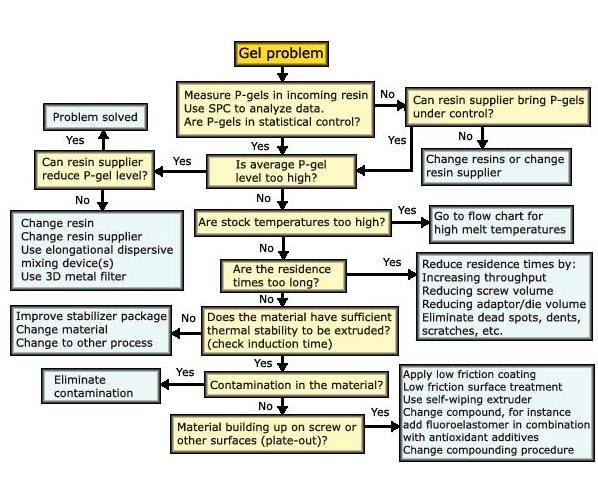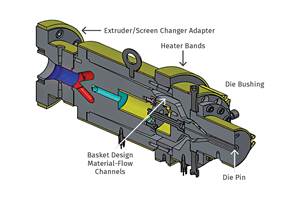Solving Gels in Thin Film, Tubing Extrusion
Gels are a common quality problem in thin film and tubing extrusion. To solve them, learn from where they came.
Gels are a common quality problem in extrusion of clear film and tubing less than 0.005 in. thick. Gels are primarily visual defects caused by small bits of higher-molecular-weight material or contamination that reflect and transmit light differently from the rest of the material. They aren't problems in opaque or thick-walled products (over 0.02 in.), where they aren't visible.
Gels can come from several sources: HMW tails in a bimodal resin, crosslinked material caused by overheating, additives with poor thermal stability, fines from regrind, catalyst residue such as silica, and other organic or inorganic contamination.
As a result of shear forces in extruders, gels usually end up as elongated ellipses. Those caused by contamination typically have a dot or "fisheye" in the center; gels caused by HMW material do not. When gels consist of HMW droplets, they are primarily a cosmetic problem. Gels caused by contamination, however, can produce a weak point in a tube or even start a hole in film.
If you have gels in an extruded product, it's important to know whether they originated in the incoming raw material or were created during extrusion. Gels formed during polymerization are called P-gels. They form in stagnating regions of the reactor where resin overheats. They may also be high-molecular-weight fractions created by a bimodal process or resin made when a reactor needs maintenance.
P-gels are a common problem in polyolefins. Some non-olefins also have high gel problems. PVDF can pose severe gel problems from the manufacturer, especially if it's made shortly before a maintenance turnaround. So processors using a material that's prone to gels should be aware of reactor maintenance schedules.
Gels can also form during extrusion. These are called E-gels and tend to form as a result of high temperatures or long residence times. E-gels can be created by dead spots in the extruder—e.g., stagnating regions in the screw. Maddock mixing sections, for example, can create dead spots.
Preventing P-Gels
The best defense against P-gels is to test incoming material for them and communicate clearly to resin suppliers that you do so. When resin suppliers realize they're dealing with a sophisticated user whose product requires low gel counts, they will try to send good material. Incoming QC for gels is especially important when running multi-layer film because you have more materials and extruders to check for gels.
Testing for P-gels requires a thin plaque of the material. Plaques can be prepared several ways, such as by compression molding a few pellets' worth of resin. It's important to control the pressing temperature to make sure you don't create more gels in the test process. The number of gels per unit area in the plaque can be counted using an overhead projector and polarized light to project an image on a screen. Make sure you standardize gel-test procedures within your company. They should be written and followed consistently.
If the gel level is low, or at least stable, in the incoming material, you can take steps to reduce gels during extrusion, though that's not easy. The screen pack typically used before the breaker plate doesn't capture enough gels to reduce them significantly. Adding dispersive mixing elements to a screw may reduce gels but usually won't eliminate them completely. New dispersive mixers that generate elongational flow, such as the CRD mixer sold by Rauwendaal Extrusion Engineering and The Madison Group in Madison, Wis., disperse more gels than earlier models. Also, fluoropolymer processing-aid additives, typically used to reduce melt fracture, can reduce gels in PE films.
One of the best tools available to remove gels is a "depth filtration" medium, such as a disk of porous sintered metal or a felt-like pad of random steel fibers in a 3D arrangement. These depth filters have specified ratings and have been in use for decades for extruding high-quality film and fiber that require the lowest possible gel level. However, these filters are expensive and need replacement on a regular basis.
Preventing ‘E-gels'
To avoid making gels during extrusion, be sure the screw and die have a streamlined design. Also the screw, barrel, and die surfaces should be free of grooves, scratches, or gouges that might collect melt and cause degradation.
It's also important to check resin feed tubes, blenders, feeders, hoppers, and other bulk-handling hardware for fines, streamers, or contamination from other plastics. Bulk-handling equipment should be completely blown down and cleaned when you change resins.
Another way to reduce gels is to start up the extruder with a highly stabilized version of the plastic, or even a different and more stable plastic, to coat critical surfaces with a degradation-resistant layer.
There are several methods to count gels in film. There is a little-used standard for manual counting in samples off-line. Automatic methods based on lasers or CCD cameras are used to monitor gels in production. An ASTM procedure has been proposed for automatic gel detection, but certain issues are still unresolved—such as how to report results, and what size gels to count.
Case of a gel detective
Sometimes the line between P- and E-gels gets blurred. In an actual case, a processor making monolayer cast film out of natural PP homopolymer had a serious appearance problem with gels. The processor's first step was to determine the nature of the gels, so the region around the blemishes was examined under a microscope. The film was cut through the gel to allow examination of a cross-section. Then the sample was embedded in epoxy resin and polished after curing the epoxy. A micro-photograph was taken at 200X magnification with a Leica optical microscope (Laborlux 12 Pol S) equipped with polishing and microtome capabilities.
The sample was illuminated with polarized light and the transmitted light was photographed. In the photo, the processor could see that the gel had a black speck in its center, indicating the cause was degradation or other contamination. Thus, the next step was to check the operation of the extruder—a fully instrumented 7.8-in., single-screw machine with a cast-film die and machine-direction orienters. Thorough troubleshooting means not taking anything for granted. So the next step was to check the accuracy of the melt-temperature probes.
This was accomplished by using extrusion simulation software to predict conditions in the extruder, given the resin used, screw speed, die restriction, and barrel-heater set temperatures. The computer simulation cast doubt on the accuracy of the melt probes by predicting much higher melt temperatures than the sensors showed. Melt temperature was estimated at 547 F, very high for homopolymer PP film. Recommended melt temperature would be around 500 F.
So barrel temperatures were lowered, aiming for a melt temperature at the die of 500 F. That temperature, however, caused too much backpressure. The lowest melt temperature possible was 518 F, at which gels were less noticeable but still present.
The screw design, which included a 4D dispersive mixer with a barrier, was considered appropriate for PP. The machine set-up was also checked for problems, but none were found.
Next the polymer itself was investigated. A polymer sample without additives was sent out for thermogravimetric analysis, which showed 1% loss of weight at 685 F. This ruled out degradation of the PP.
That left the additive package, a masterbatch of slip and anti-block agents, as the likely culprit. The additive supplier was contacted and changed the carrier material to one that was less heat and shear sensitive. When this change was made, the gel problem disappeared completely.
Chris Rauwendaal has worked in extrusion for nearly 30 years. He heads his own consulting firm in Los Altos Hills, Calif., which provides screw and die designs and process troubleshooting services. The author welcomes readers’ questions or comments by e-mail: chris@rauwendaal.com. Previous articles in this series can be found at www.ptonline.com.
Related Content
Part 2 Medical Tubing: Use Simulation to Troubleshoot, Optimize Processing & Dies
Simulation can determine whether a die has regions of low shear rate and shear stress on the metal surface where the polymer would ultimately degrade, and can help processors design dies better suited for their projects.
Read MoreWhat to Know About Your Materials When Choosing a Feeder
Feeder performance is crucial to operating extrusion and compounding lines. And consistent, reliable feeding depends in large part on selecting a feeder compatible with the materials and additives you intend to process. Follow these tips to analyze your feeder requirements.
Read MoreThe Importance of Barrel Heat and Melt Temperature
Barrel temperature may impact melting in the case of very small extruders running very slowly. Otherwise, melting is mainly the result of shear heating of the polymer.
Read MoreHow to Select the Right Tooling for Pipe Extrusion
In pipe extrusion, selecting or building a complementary set of tooling often poses challenges due to a range of qualitative factors. Here’s some guidance to help you out.
Read MoreRead Next
For PLASTICS' CEO Seaholm, NPE to Shine Light on Sustainability Successes
With advocacy, communication and sustainability as three main pillars, Seaholm leads a trade association to NPE that ‘is more active today than we have ever been.’
Read MorePeople 4.0 – How to Get Buy-In from Your Staff for Industry 4.0 Systems
Implementing a production monitoring system as the foundation of a ‘smart factory’ is about integrating people with new technology as much as it is about integrating machines and computers. Here are tips from a company that has gone through the process.
Read More





















